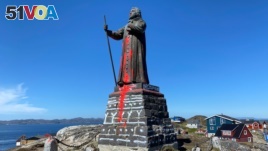04 July 2020
In Greenland, a 21-year-old hip-hop artist is the face of the local Black Lives Matter movement.
His name is Josef Tarrak-Petrussen. Some of his music talks about opposition to colonial rule. The songs are a favorite among younger Greenlanders seeking to rewrite their history.

The statue of Hans Egede is seen after being vandalized in Nuuk, Greenland June 21, 2020. (Ritzau Scanpix/via REUTERS)
The Black Lives Matter protests have inspired people all over the world to look at and condemn injustice and past oppression.
In Greenland, the protests have fueled old tensions with its former colonial ruler, Denmark.
Greenland is the world's largest island. It sits between the Arctic and Atlantic Oceans. The island is now a self-governing territory of Denmark.
For one hundred years, the statue of Danish-Norwegian colonist Hans Egede has stood in Nuuk, Greenland's largest city and capital. The Black Lives Matter protests have led to calls for the statue's removal.
"We should do as the rest of the world is doing and remove it," Tarrak-Petrussen said. "It's a part of the oppression here in Greenland and the systemic racism."
Tarrak-Petrussen has a Greenlandic mother and Moroccan father. He has traditional Greenlandic tattoos on his face.
In a music video filmed in front of the statue, he raps in Greenlandic about how Danes call locals "drunks," "Eskimo pakis" and "Arctic monkeys." Tarrak-Petrussen asks, "Are we still a colonized people?"
Greenlandic lawmaker Aki-Matilde Hoegh-Dam called the statue a sign of colonial violence and suggested putting it in a museum.
An online effort to move the statue gathered nearly 2,000 signatures in one week. That is more than 10 percent of Nuuk's population.
On June 21, Greenland's National Day, the word "decolonize" was written on the statue. It also got covered with red paint. A different statue of Egede, in the Danish capital Copenhagen, also was damaged.
"The younger generations will no longer accept the way others have written their history - they want to start telling their own story," said Ebbe Volquardsen. Volquardsen is an associate professor of cultural history at the University of Greenland.
Hans Egede arrived in 1721 to spread Christianity. His arrival marked the beginning of Danish colonial rule. Volquardsen described the colonization as mostly nonviolent, with no slavery or huge riots.
Nuuk's mayor Charlotte Ludvigsen last month called for a public meeting to let citizens decide the statue's future.
"Much of the criticism of Hans Egede is that he forced Christianity and the Western way of life on Greenlanders," she said.
Greenland remained a Danish colony until 1953. It then became part of the Kingdom of Denmark. It was given self-governing autonomy in 2009. This included the right to declare independence.
However, the island of 56,000 people is unlikely to do so anytime soon as it depends heavily on Denmark for economic aid.
Many Greenlanders say they face limited chances of getting good schooling or a good job in part because of their native language and culture.
I'm Ashley Thompson.
The Reuters news agency reported this story. Ashley Thompson adapted it for VOA Learning English. George Grow was the editor.
____________________________________________________________
Words in This Story
hip-hop - n. rap music
inspire - v. to make (someone) want to do something : to give (someone) an idea about what to do or create
statue - n. a figure usually of a person or animal that is made from stone, metal, etc.
tattoo - n. a picture, word, etc., that is drawn on a person's skin by using a needle and ink
rap - v. to perform rap music or a rap song
museum - n. a building in which interesting and valuable things (such as paintings and sculptures or scientific or historical objects) are collected and shown to the public
autonomy - n. the power or right of a country, group, etc., to govern itself